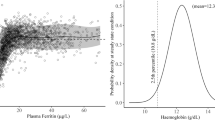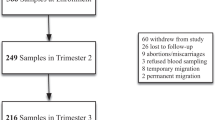Abstract
Objectives:
The acute phase response (APR) influences indicators of iron status. A recent WHO/CDC consultation recommended concurrent measurement of α-1-acid-glycoprotein (AGP) in surveys to control for the APR, and aid in interpreting iron status. They proposed further exploratory analyses using AGP. We examined whether the APR (measured by AGP) influences the expected relationships between iron status indicators in an HIV-infected population.
Subjects:
We measured hemoglobin (Hb), serum ferritin (SF), transferrin receptor (TfR), erythropoietin (EPO) and AGP in a cross-sectional survey of 643 HIV-positive Zimbabwean women.
Results:
SF was significantly higher in APR-positive (AGP>1 g/l) women (P<0.001), in whom there was no association between SF and Hb. TfR was inversely associated with Hb, in both APR-positive and APR-negative women (P<0.001). However, among anemic women (Hb<110 g/l), APR-positive women had marginally lower TfR concentrations (P=0.053). There was no difference in EPO response to decreasing Hb among APR-positive and APR-negative women.
Conclusions:
AGP captured the influence of the APR on iron indicators and their relationships with each other. The APR influenced SF and its relationship with Hb as expected. TfR behaved unexpectedly. Although TfR has been promoted as an iron indicator that is uninfluenced by the APR, TfR concentrations were depressed among anemic APR-positive women. Because TfR reflects iron deficiency and erythropoietic activity, pro-inflammatory cytokines associated with the APR may be inhibiting erythropoeisis, which is reflected by lower TfR concentrations. We support the WHO/CDC recommendation that AGP is a useful indicator to assess the influence of the APR on iron status indicators.
This is a preview of subscription content, access via your institution
Access options
Subscribe to this journal
Receive 12 print issues and online access
$259.00 per year
only $21.58 per issue
Buy this article
- Purchase on Springer Link
- Instant access to full article PDF
Prices may be subject to local taxes which are calculated during checkout



Similar content being viewed by others
References
Beesley R, Filteau S, Tomkins A, Doherty T, Ayles H, Reid A et al. (2000). Impact of acute malaria on plasma concentrations of transferrin receptors. Trans R Soc Trop Med Hyg 94, 295–298.
Beguin Y (2003). Soluble transferrin receptor for the evaluation of erythropoiesis and iron status. Clin Chim Acta 329, 9–22.
Feelders RA, Vreugdenhil G, Eggermont AM, Kuiper-Kramer PA, van Eijk HG, Swaak AJ (1998). Regulation of iron metabolism in the acute-phase response: interferon gamma and tumour necrosis factor alpha induce hypoferraemia, ferritin production and a decrease in circulating transferrin receptors in cancer patients. Eur J Clin Invest 28, 520–527.
Ferguson BJ, Skikne BS, Simpson KM, Baynes RD, Cook JD (1992). Serum transferrin receptor distinguishes the anemia of chronic disease from iron deficiency anemia. J Lab Clin Med 119, 385–390.
Filteau SM, Morris SS, Abbott RA, Tomkins AM, Kirkwood BR, Arthur P et al. (1993). Influence of morbidity on serum retinol of children in a community-based study in northern Ghana. Am J Clin Nutr 58, 192–197.
Fournier T, Medjoubi NN, Porquet D (2000). Alpha-1-acid glycoprotein. Biochim Biophys Acta 1482, 157–171.
Gabay C, Kushner I (1999). Acute-phase proteins and other systemic responses to inflammation. N Engl J Med 340, 448–454.
Humphrey JH, Hargrove JW, Malaba LC, Iliff PJ, Moulton LH, Mutasa K et al. (2006a). HIV incidence among post-partum women in Zimbabwe: risk factors and the effect of vitamin A supplementation. Aids 20, 1437–1446.
Humphrey JH, Iliff PJ, Marinda ET, Mutasa K, Moulton LH, Chidawanyika H et al. (2006b). Effects of a single large dose of vitamin A, given during the postpartum period to HIV-positive women and their infants, on child HIV infection, HIV-free survival, and mortality. J Infect Dis 193, 860–871.
Jelkmann W (1998). Proinflammatory cytokines lowering erythropoietin production. J Interferon Cytokine Res 18, 555–559.
Kling PJ, Roberts RA, Widness JA (1998). Plasma transferrin receptor levels and indices of erythropoiesis and iron status in healthy term infants. J Pediatr Hematol Oncol 20, 309–314.
Kohgo Y, Niitsu Y, Kondo H, Kato J, Tsushima N, Sasaki K et al. (1987). Serum transferrin receptor as a new index of erythropoiesis. Blood 70, 1955–1958.
Leng HM, Folb PI (1996). Erythropoiesis and erythropoietin synthesis during aseptic acute inflammation. Inflamm Res 45, 541–545.
Menendez C, Quinto LL, Kahigwa E, Alvarez L, Fernandez R, Gimenez N et al. (2001). Effect of malaria on soluble transferrin receptor levels in Tanzanian infants. Am J Trop Med Hyg 65, 138–142.
Mockenhaupt FP, May J, Stark K, Falusi AG, Meyer CG, Bienzle U (1999). Serum transferrin receptor levels are increased in asymptomatic and mild Plasmodium falciparum-infection. Haematologica 84, 869–873.
Semba RD, Gray GE (2001). Pathogenesis of anemia during human immunodeficiency virus infection. J Investig Med 49, 225–239.
Spivak JL (2000). The blood in systemic disorders. Lancet 355, 1707–1712.
Stenvinkel P (2003). Anaemia and inflammation: what are the implications for the nephrologist? Nephrol Dial Transplant 18 (Suppl 8), viii17–viii22.
Stoltzfus RJ, Chwaya HM, Montresor A, Albonico M, Savioli L, Tielsch JM (2000). Malaria, hookworms and recent fever are related to anemia and iron status indicators in 0- to 5-y old Zanzibari children and these relationships change with age. J Nutr 130, 1724–1733.
Stoltzfus RJ, Mullany L, Black RE (2005). Iron deficiency anemia. In: Ezzati M, Lopez AD, Rogers A, Murray CJL (eds). Comparative Quantification of Health Risks: The Global and Regional Burden of Disease due to 25 Selected Major Risk Factors. pp 163–209. World Health Organization: Geneva.
Thurnham DI, Mburu AS, Mwaniki DL, De Wagt A (2005). Micronutrients in childhood and the influence of subclinical inflammation. Proc Nutr Soc 64, 502–509.
Thurnham DI, McCabe GP, Northrop-Clewes CA, Nestel P (2003). Effects of subclinical infection on plasma retinol concentrations and assessment of prevalence of vitamin A deficiency: meta-analysis. Lancet 362, 2052–2058.
Thurnham DI, Northrop-Clewes CA (2004). Effects of infection on nutritional and immune status. In: Hughes DA, Darlington LG, Bendich A (eds). Diet and Immune Function. pp 35–64. Humana Press: Totowa.
Tomkins A (2003). Assessing micronutrient status in the presence of inflammation. J Nutr 133, 1649S–1655S.
Verhoef H, West CE, Ndeto P, Burema J, Beguin Y, Kok FJ (2001). Serum transferrin receptor concentration indicates increased erythropoiesis in Kenyan children with asymptomatic malaria. Am J Clin Nutr 74, 767–775.
Weiss G, Goodnough LT (2005). Anemia of chronic disease. N Engl J Med 352, 1011–1023.
WHO (2001). Iron Deficiency Aneaemia. Assessment, Prevention, and Control. A Guide for Programme Managers, WHO: Geneva.
WHO/CDC (2005). Assessment of Iron status at the Population Level: Report of a Joint WHO/CDC Technical Consultation Geneva. WHO/CDC: Switzerland.
Wieringa FT, Dijkhuizen MA, West CE, Northrop-Clewes CA, Muhilal (2002). Estimation of the effect of the acute phase response on indicators of micronutrient status in Indonesian infants. J Nutr 132, 3061–3066.
Williams TN, Maitland K, Rees DC, Peto TE, Bowden DK, Weatherall DJ et al. (1999). Reduced soluble transferrin receptor concentrations in acute malaria in Vanuatu. Am J Trop Med Hyg 60, 875–878.
Witte DL (1991). Can serum ferritin be effectively interpreted in the presence of the acute-phase response? Clin Chem 37, 484–485.
Acknowledgements
The ZVITAMBO project was supported by the Canadian International Development Agency (CIDA) (R/C Project 690/M3688), United States Agency for International Development (USAID) (cooperative agreement number HRN-A-00-97-00015-00 between Johns Hopkins University and the Office of Health and Nutrition—USAID) and a grant from the Bill and Melinda Gates Foundation, Seattle WA. Additional funding was received from the Nestle Foundation (Lausanne, Switzerland), Rockefeller Foundation (New York, NY) and Cornell University (Ithaca, NY).
Author information
Authors and Affiliations
Corresponding author
Rights and permissions
About this article
Cite this article
Rawat, R., Stoltzfus, R., Ntozini, R. et al. Influence of inflammation as measured by α-1-acid glycoprotein on iron status indicators among HIV-positive postpartum Zimbabwean women. Eur J Clin Nutr 63, 787–793 (2009). https://doi.org/10.1038/ejcn.2008.33
Received:
Revised:
Accepted:
Published:
Issue Date:
DOI: https://doi.org/10.1038/ejcn.2008.33
Keywords
This article is cited by
-
Anemia and iron homeostasis in a cohort of HIV-infected patients in Indonesia
BMC Infectious Diseases (2011)



